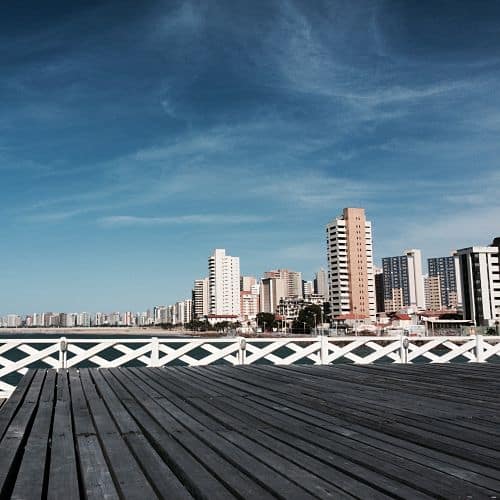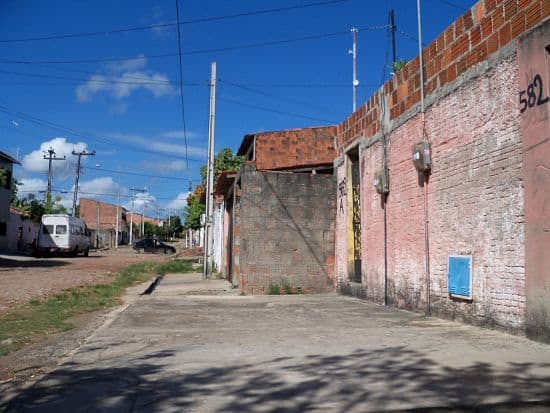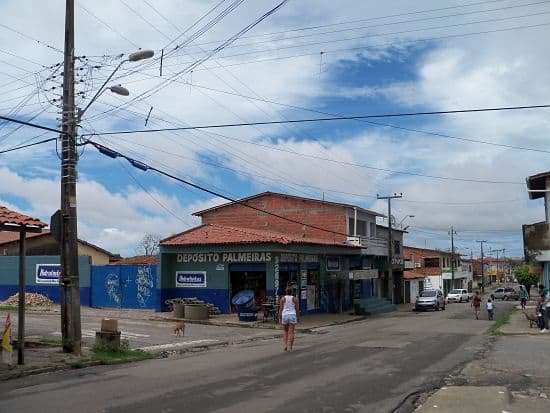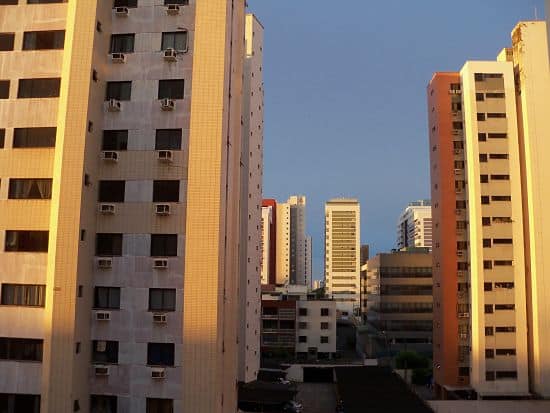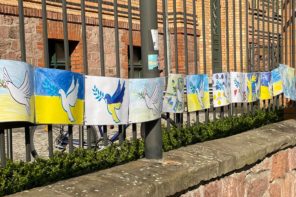I started my own journey in the Brazilian northeast, on the plane from Rio de Janeiro to Fortaleza, Ceará, with a dream. After wandering around the airport, hot like an oven at 400 degrees, searching for the right gate like a shaman for the right answer, I found myself pushed onto a plane for Salvador de Bahia. Not my destination but a stop on my way to Fortaleza: “We will take you there too!” an airport employee told me. As if traveling by plane was somehow like a car ride. Exhausted and sweaty, I had finally managed to enjoy the benefits of air conditioning in my plane seat, wedged in between two Brazilian women. One of them, an old lady, soon started snoring, maybe dreaming of something remote and peaceful. The other one didn’t take long to share her story of migration with me, a tale about thieves and the solitude of life in Rio de Janeiro. Here I was, fieldworking sooner and more easily than I expected. But I wasn’t ready for this abrupt beginning, so soon after she finished her story, I fell asleep. I fell asleep and I dreamt of an ample white valley, covered in snow and full of thin black trees. I woke up happy, energized, like after a good night of sleep.
My 2015 trip to Fortaleza, to the capital city of the Brazilian northeastern state of Ceará, was, like any ethnographic experience surprising and eventful. Interested in the symbolic dimension of money and the forms of trust and relationships it embeds, I landed here to understand closely how a poor community, at the margins of the city, managed to create its own money and its own bank. Fortaleza is Brazil’s fifth largest city and a major tourist destination, with exotic beaches, skyscraper hotels, palm trees and relatively low prices for the Western pockets. But according to a recent study, Fortaleza also happens to be one of Brazil’s most violent cities (Metodología del Ranking 2017), judging by the homicide rates, news that made it even to international media (de Oliveira 2016). Additionally, and somehow explaining the high homicide rates, Fortaleza is, according to a UN report, the word’s second most unequal city (López Moreno, Oyeyinka, and Mboup 2008). Without romanticizing inequality, where there is a lot of poverty, there are also examples of human creativity and resiliency. While in Mireilles, one of the wealthiest neighborhoods of the city, situated close to the beach, the malls and supermarkets sell Brie, Belgian beer, Swiss watches, Apple products, and French perfumes, for the mainly “white” middle and upper class Brazilians, Conjunto Palmeiras is, judging by the human development index, the poorest neighborhood of Fortaleza, situated literally at the edge of the city. There, poverty taught the city’s poorest residents, that without actively demanding their rights, they might have to wait long until the State will remember them.
Conjunto Palmeiras was created in 1973 as a place of and for the continually displaced — by economic “development”, drought in the interior of the state, and flooding in the city — and the poorest citizens. The three buses that one needs to take from Mireilles to Conjunto Palmeiras take you, in a two-hours journey, through the last one hundred years of the city’s highly unequal development, but paradoxically the trip also keeps you very much in the present.
Colors change, people change, roads change.
Mireilles is mainly white but as you go deep into the heart of the city and then towards the periphery you see a slow but clear transition towards brown and black. As if someone had colored the city with a fine pen. It’s right here, at the margins of the city, in Conjunto Palmeiras that community leaders created the Palmas Bank, a community bank circulating until recently the Palma, the most popular local currency of this type in Latin America and an example among activists in the region (Seyfang and Longhurst 2013). And it’s this story of paradoxes and contradictions that brought me to Brazil each year since 2013. Many Latin American and Brazilian scholars had written about the Palmas Bank and when I started fieldwork, I considered myself “prepared”; as prepared as one can be.
The social disparities that became more obvious with Brazil’s transition to democracy, and the symptom of these now visible social inequalities — the drug trade — have taken over major Latin American cities more than a decade ago; and Fortaleza is no exception. In Conjunto Palmeiras, like anywhere at the periphery of Fortaleza and even in its better-off areas, houses are fended in by high brick walls and tall metal gates bar at the entrance. The same applies to schools and public institutions, all guarded by the police officers, who often patrol around the school yard. Assaults in buses are part of the daily routine for most resident who have to rely on public transportation. Conjunto Palmeiras, once a “community” of 4,000 residents in 1970, grew to a neighborhood of 40,000 over 40 years, split into sometimes street level units by the invisible walls of the drug trafficking. With this in mind, the question of how do people work locally to change their condition became even more important. Their will to change the neighborhood has now to pass the test of the everyday fear generated by the drug trade and its new local divisions of space.
Even though the focus of my research was not urban violence, discussing the way my friends and acquaintances lived in a constant fear became a moral obligation. In my personal struggle to stay safe, as a white woman commuting two hours a day per bus, and wandering around Conjunto Palmeiras, nightmares became part of my daily routine. They would often reproduce in images stories that I had heard during the day. They were a vivid, loud, and distressing depiction of moments when I was – as my informants often put it- “lucky” not to be there. Luck was not really luck, because we were all aware that if a white European gringa was harmed, the Police would come to the neighborhood and try to find “a” culprit.
Where I grew up — a small town on the Black Sea coast in Romania — dreams are literally mystical moments that need to be disassembled of all their meanings around a coffee the next morning. In my dreams and the dreams of my relatives, departed dear ones from the afterlife send us news about their lives there. We respond back, like good Christians, by spending the next day making their favorite dishes and then sharing them with a friend, a neighbor, or a beggar. In other times, at night we receive clues or sprinkles of hope when we needed it most. Dreaming of snow is a good sign; something good will happen. Dreaming of water or a sea means that you are worried about something. Night dreams and daydreams are two different things. The night dreams inform what I fantasize about during the day, they act like street signs that direct the course of many of my decisions during the day.
In Brazil, my informants would often share their dreams, especially when in a group with other friends and colleagues. But there, the dreams they shared with me or my dreams didn’t seem to fit any of the interpretations I was familiar with. There was no snow, no water, no news from the other world. And therefore, no more clues and directions about where to head the next morning or the days after. This is not to say that they didn’t have the same dreams about departed loved ones that I used to have back home, but for some reason, these were not the dreams that they would share. When I asked about what they dreamed of, or when they told me without prompting, more stories of violence emerged, leading me to believe that both their night and day dreams seemed to be permeated by a constant fear that they experienced every day.
This fear and expectancy that anything can happen anytime feels like a long and never-ending nightmare.
Just like Linda Green frames it, fear is a way of life that you don’t get any breaks from, not even when you sleep. Perhaps even less, then (Green 1999). Each day one had to avoid assaults in buses, be alert and always decipher the geographies of fear and violence.
This included avoiding walking on empty streets at noon, when the sun hit the most and most people were indoors, and consequently, when many assaults took place. Or being mindful of empty streets with street bumps- probably a sign that an important drug dealer was living there and the street bumps warned him when the police car was nearby. And most importantly, learning when to take the bus: avoid the less busy hours of 9 am to 3 pm when people are at work; empty buses often mean assaults; when you see people moving in a group towards the front of the bus, you follow them, it means that in the back of the bus there is someone who will soon show a knife and ask everyone to leave their phones on the ground. With every bus stop, passengers would examine the new group of people who entered the bus and after a quick scan, continue watching their phones and relax until the next stop… There are countless examples of strategies that people put in place in order to learn how to live with violence and anthropologists have documented extensively many of these practices but less is known though about the role dreams play into such contexts.
Since the 1940s anthropologists started interpreting dreams as windows to the worlds they aimed at understanding. Many anthropologists have attempted to understand dreams as part of the symbolic life of remote populations from different corners of the world. In the 1940s, for example, Dorothy Eggan, taking as a reference of the Hopi dreams, hoped that anthropologists could study dreams to understand the extent to which fantasy was important for “nonliterate people” (1949). Others would seek to understand through dreams the different facets of religious practices or the links between religion and power (Eves 2011). Dreams — just like the people studied — seemed one more exotic ethnographic material. But in the context of 21st-century inequality and structural violence, dreams seem to gain new meanings — now they speak loudly about the continuum between night and day and the fear that accompanies both. Probably more than this, dreams in a context of violence speak about how deeply engrained structural problems are in the lives of people situated literally at the margins of the economy and the state.
“I would like to buy a car. We had a motorcycle. We had to sell it because there were too many assaults. We made some changes at the house. They could have stolen the car; it would be better parking inside the house, in a garage, instead of having it stolen. For my kids, I want them to have a college degree … study law, become a lawyer, a doctor. But not a cop. Only if they want to become judges. Because the laws here — if you don’t have someone inside — you die if you don’t have laws or someone to defend you. We don’t trust them. Look, the other day no one could sleep in our block. They started playing music really loud. The police came by because we called but they left. Why? Because they gave them money. The police stopped by again, took more money and left. What is the use of having the Police? I have cousins in the interior (of the state) and they think it’s better working there because it’s safer. Here you can die anytime.” (Maria, 30 years old, NGO worker, Fortaleza)
In this narrative Maria discusses her plans for the future, plans inspired by her living on “Esquina do Pecado,” or literally the Corner of the sin, a street corner in her neighborhood known for the “sins” that some have committed there. The collective naming of streets with reference to dramatic events that took place in the neighborhood speaks loudly about the violence that deeply penetrates places and people’s memories of their living spaces. Maria talked about changes in her house and strategies of both physical and social mobility, based on her broader strategies of staying safe and avoiding physical violence, which is the only type of violence that she can actually avoid. For many, like Maria, violência determines what you can and cannot do but also what you and your children might become tomorrow. It could be said that in Eric Wolf’s terms, violência is embedded with structural power (Wolf 1999) because it delimits what can and can’t be done. If dreams reproduce and deepen a state of fear and insecurity that one experiences during the day, how can someone find an exit from this loop? Plans and expectations that one has about the future are limited by what one sees as opportunities.
Night dreams cannot go too far from the daily life in poverty and fear.
But paradoxically, violence, while keeping residents alert, also teaches new ways of caring and loving, and these interactions are capable of generating the so much needed hope.
For people with greater mobility, like the school teachers or the health agents (social workers employed by the local clinics), being able to navigate the streets of the neighborhood “freely” constitutes both a capital and a burden. School teachers and health agents are trusted and respected for the important job they do. This legitimacy and importance provide them with a certain protection from the drug gangs. They can move more easily from house to house, but in this movement they capture fragments of life they sometimes wish they didn’t hear, or like Fatima, a friend of mine, puts it, “I get scared once I hear the patients talking to me because I might not want to hear what they have to tell me.” Some health agents are commuters between day and night and use their legitimacy to do community activism in their very own way:
“I had a dream. The spirit of the death was around and wanted to grab my friend’s son. I went to my friend’s house and together we prayed and sought a rehab center for him. He stood there for two weeks and then he ran away with some other kid to find drugs.” (Vera, 43 years old, health agent, Fortaleza)
Vera, for example, shared with me her dreams in one of the visits to the bedridden patients in her area. Since then, each time we met she shared these dreams with me like a big secret that you only share to close friends. In our visits, I could also see how she acted upon her dreams and used the same mystery and secrecy with certain people to convince their children to distance themselves from the drug traffic. In the past, her warning dreams have proven correct, so many of her neighbors now saw her dreams as embedded with premonitory potential and therefore important to take into consideration. Such examples are an indication of the resiliency people find when living at the margins of the state and the economy, and even when their lives are being threatened every day. The need to hope and have faith that there is a logic that governs this absurd reality when resources are unreliable, makes people like my friends to creatively make sense of the unpredictable that characterizes their lives. In this way, they become creators of meaning and reinterpret mundane events in a process that we, anthropologists, like to call culture.
If health agents get stuck between the secrets of their patients, and the incapacity to do something about them, something similar could be said about the ethnographer, immobilized in a corner by guilt and pain. The stories people share are often poisoned gifts: they are signs of deep friendship and intimacy but they also leave the listener with the burden of doing something with and for them. Such would be the story of Bianca, a girl I have met when accompanying school teachers in their daily work:
“In the future when I will be old I want to study, get a degree, become a firefighter. I want to see the queen of the Indians, the indigenous people that the Portuguese attacked here. When I will be 25 I want to marry and have a son. I only want to have a son but I want to adopt him….because there are enough babies lying there. One of these days women threw away a baby in the garbage bin, there where I live. My mom picked him up and found a place for him. The woman said ‘Thank you’. I think that woman didn’t want to have the baby … but why did she throw it in the bin? I think she had regrets in her little heart. I’ve never seen that woman again.” (Bianca, 8 years old, Fortaleza)
Bianca shared this short reflection, which points to her need to make sense of cruel reality that she is embedded in, by talking out loud. But probably more surprisingly than that, it was the shock to hear an 8-year-old child talking about violence with the normalcy and maturity of an adult. In her brief story cruelty is normalized but nonetheless not accepted. In a way, this reflection points to the fact that in the midst of all the violence she testifies every day, children like Bianca find – almost out of nowhere- the courage, power and energy to hope and see the future in a bright light. She is both mature and full of hope, which in this context seems like a contradiction or a paradox. The kind of maturity she displays here is, unfortunately, not uncommon among children of their age.
The first day when I started working as a volunteer for a local NGO one of the employees, Camila, an Argentinean woman of my age described in a few words the kind of teenagers I was going to work with: “They seem like all the others you have met so far with a single difference: they don’t have dreams.” In saying this Camila was probably making sense of her own despair towards the local problems and the future of children at the margins of the city. In her imaginary this was the worst thing that could happen to a child: not dreaming, not having hope, not being able to trust the future. But stories like Bianca’s stand as a proof that children at the margin of the city do dare to dream, and this is probably their greatest act of courage and power.
Considering that the problems of Fortaleza are the problems of most (Latin) American cities, and that structural violence is becoming more and more naturalized, anthropologists should reconsider the importance of dreams in such context and the meanings they have for the people who inhabit them. Dreams are no more glimpses of exotic worlds that we won’t have access to otherwise, nor are they remote realities. Instead, dreams mirror the deeply rooted nature of the structural violence and poverty that we become each day more familiar to. If resistance is possible when we decide not to take such reality for granted, and we reject its “normality”, dreams are a constant wakeup call reminding us of the deeply structural dimensions of power and poverty. Moreover, this time it’s also us, anthropologists, who get palpable glimpses of the worlds we are trying to make sense of and we have the moral duty to do something with and about them.
References
Eggan, Dorothy
1949 The Significance of Dreams of Anthropological Research. American Anthropologist 51(2): 177–189.
Eves, Richard
2011 Pentecostal Dreaming and Technologies of Governmentality in a Melanesian Society. American Anthropologist 38(4): 758–773.
Green, Linda
1999 Fear as a Way of Life. Mayan Widows in Rural Guatemala. New York: Columbia University Press.
López Moreno, Eduardo, Oyebanji Oyeyinka, and Gora Mboup
2008 State of the World’s Cities 2010/2011. Bridging the Urban Divide. London: UN Habitat.
Metodología Del Ranking (2016) de Las 50 Ciudades Más Violentas Del Mundo
2017. Seguridad, Justicia, e Paz.
de Oliveira, Cleuci
2016 Brazil Grapples with Lynch Mob Epidemic: “A Good Criminal Is a Dead Criminal.” The Guardian, December 6.
Seyfang, Gill, and Noel Longhurst
2013 Growing Green Money? Mapping Community Currencies for Sustainable Development. Ecological Economics(86): 65–77.
Wolf, Eric
1999 Envisioning Power. Ideologies of Dominance and Crisis. Berkeley: University of California Press.

